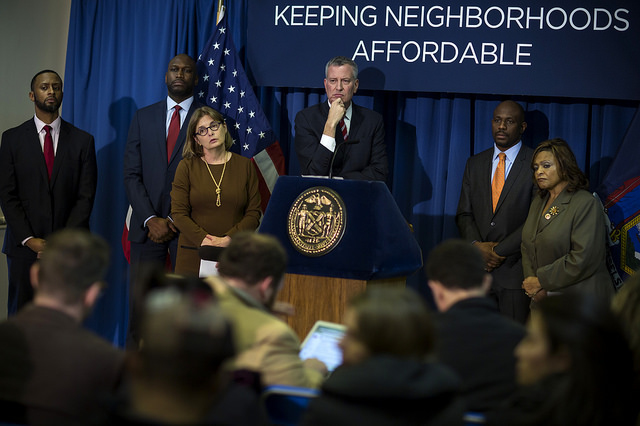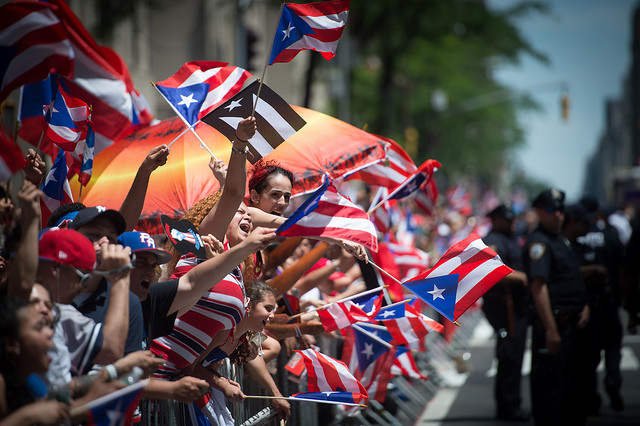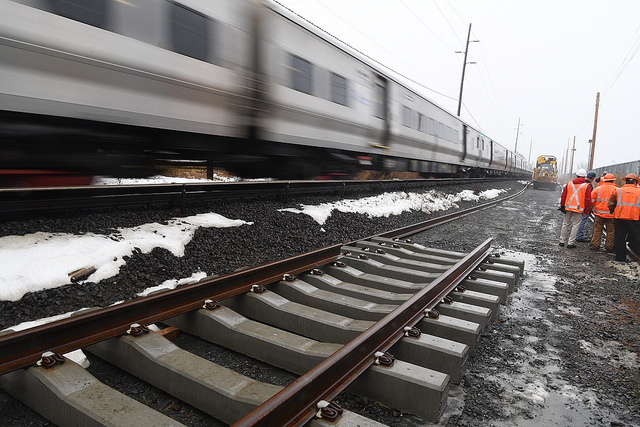‘Fairest Big City’ Wouldn’t Keep Homeless New Yorkers Out of Housing

Mayor de Blasio (photo: Ed Reed/Mayoral Photography Office)
In February at Mayor de Blasio's State of the City address, we heard plans to make New York City "the fairest big city in America." During his speech, the mayor talked about affordable housing, universal pre-K, and even global warming. But who was forgotten in his speech? The more than 64,000 homeless New Yorkers who face discrimination every day in their search for housing and stability.
I am one of the 64,000 people living in a shelter in this "fair" city. I've been homeless for over a year. I was first given the Special Exit and Prevention Supplement (SEPS) voucher last July. SEPS is a program that is supposed to help me secure housing and pay a portion of my rent—but I've been unable to find a landlord who will accept it, even though refusing vouchers is illegal in New York City. My story is not unique. Thousands of homeless New Yorkers like me can pay rent but can’t find housing due to rampant source-of-income discrimination by landlords and brokers. This isn’t just plain wrong, it’s against the law.
In fact, in 2008, Mayor de Blasio himself (then a City Council member) wrote legislation amending the Human Rights Law to include protections from source-of-income discrimination, and celebrated this victory as making New York City one of the strongest anti-discrimination cities in the country.
I work four days a week, go to school on Fridays, and in my few free moments, I search for housing. I see a housing specialist, I call brokers who who post ads for apartments, and I fill out applications for the affordable housing lottery. I have conversation after conversation at my church, in my workplace, and at school, to find out if anyone has a new lead for housing. This process has exhausted me, tested my mental and physical health, and above all, has made me angry that anyone could call this city "fair" or on the way to “fairest.”
The mayor began his first term promising to "end the tale of two cities," and began his second with the “fairest big city” goal. Meanwhile, he's created so little deeply affordable housing and not nearly enough support for the thousands of us who are without a home. Without real action, a slogan of "fairness" is a slap in the face to New Yorkers who are homeless and discriminated against.
Now, I hear Mayor de Blasio is proposing to cut $1.7 million from the city’s Commission on Human Rights (CCHR)—the agency in charge of helping people who face discrimination. I know that these rental assistance programs are riddled with problems, and they are not the perfect solution to homelessness. But right now, they are the most immediate ticket out of this struggle, and their use must be protected.
Homeless New Yorkers and advocates rallied at City Hall recently to protest Mayor de Blasio’s proposed budget cuts to the CCHR. The administration's response angered me more: we were made to feel like our demands were unreasonable and were told that the cuts would not impact the source-of-income discrimination work at the CCHR. We heard that all five people who currently make up that unit won't be impacted at all. Even so -- five people to protect tens of thousands' right to housing!
Any money cut to the commission renders its work less effective, period. Any cut signals to New Yorkers that the mayor simply does not consider the anti-discrimination work of the commission a priority. And most of all, allowing the CCHR to exist without adequate resources represents Mayor de Blasio’s fragmented and flawed approach to solving homelessness.
If Mayor de Blasio wants to make New York City “the fairest big city in America,” he can start by doing everything in his power to make sure the city's most vulnerable people are protected by the law and can find permanent housing.
***
Georgia Morgan is a member of VOCAL-NY, a grassroots organization that builds power among low-income people impacted by homelessness, HIV/AIDS, drug use, and mass incarceration. On Twitter @VOCALNewYork.
***
Have an op-ed idea or submission for Gotham Gazette? Email This email address is being protected from spambots. You need JavaScript enabled to view it.
Latino New Yorkers Must Find Common Ground to Move Toward Progress

Puerto Rican Day Parade (photo: Michael Appleton/Mayor’s Office)
About 2.5 million New York City residents are Latino, making the community the second largest ethnic group in the city only after non-Latino whites. The majority of the city’s Latino population is U.S. born and nearly 80% say they speak Spanish at home.
But despite strong population growth, Latino New Yorkers face a number of adverse conditions that continue to put constraints on their economic progress. About 26.4% of all Latino families live in poverty. That number jumps to 49.9% among households led by women with children. Immigration status, high unemployment, and displacement are just a few of the pressing contributing factors leaving Latinos behind.
The Latino community must work together to shape its future.
With that in mind, last year three Latino research institutes at CUNY—the CUNY Dominican Studies Institute, Center for Puerto Rican Studies (Hunter College-CUNY) and the Mexican Studies Institute —along with other partners, held the first ever New York City Summit on Latinos (SoL-NYC), to forge advocacy coalitions to develop an action-based agenda of policy priorities that can move the Latino community forward.
As we prepare to hold the second SoL-NYC Summit on Friday, June 1, we released a set of recommendations produced at last year’s conference through the participation of over 40 representatives of Latino or Latino-serving organizations. While it identifies some of the constraints on Latinos in New York City, it also calls for immediate action.
The recommendations include education reforms responsive to the linguistic and cultural needs of our children; increasing civic and political participation of the community; better access to jobs and economic opportunities, as well as strengthening the city’s “sanctuary” status to better protect law-abiding immigrants at risk of deportation.
This year is particularly important given the federal government’s one-sided focus on immigration, the upcoming gubernatorial election, where Latinos could play a crucial role, and the still-painful devastation left in Puerto Rico by Hurricane Maria. The aftermath of Maria in particular is driving a new exodus to the New York area of Puerto Rican families, which could once again bring demographic change.
As academic institutions, we do not engage in direct action or endorse political candidates. However, we recognize the importance such strategies bring to other stakeholders as they see fit.
Latinos are not a homogeneous group. In New York City, Hispanics represent over 20 different countries of origin and national ethnicities, which can pose a challenge to finding a common agenda.
As conveners, our role is to produce data and non-partisan policy analysis as well as an important space for key stakeholders to find common ground, build alliances, and strengthen their organizing power.
Latinos are strong in numbers; we are the youngest New Yorkers, with a median age of 31 and 36% under the age of 18. We now need to come together to wake up our own sleeping giant and create change.
It is encouraging to see Latinas obtaining college degrees at a faster pace now and also represented among new candidates for office and those recently elected.
However, there are deep, ongoing challenges -- the unemployment rate is still very high, for example, at 11%, compared to the overall unemployment rate of 3.9% in New York City (as of December 2017). Who is making sure that every job creation effort at the city and state levels includes Latinos? Without good-paying jobs there is no upward mobility for a group that’s the poorest and whose diversity brings language barriers as well as different educational levels and immigration statuses. Those are the kinds of discussion our annual conference wants to foster.
While the Puerto Rican and Dominican populations have been growing and spreading around the country, New York City remains the place with the most Puerto Ricans and Dominicans anywhere in the United States. New York City is also the seat of Puerto Rican and Dominican political power at the local, state, and federal levels, given both representation and influence. The Mexican population in the city continues to grow as well, leading also to political empowerment at the city level. Overall, Latinos have become nearly one-quarter of the New York City electorate, mirroring the importance of the Latino vote on the national level.
We are calling on neighborhood leaders, organizations, and other stakeholders in the Latino community to use the conference as a powerful tool to help bring the much-needed resources Latinos need.
Latinos are in good position to drive legislative change. Let’s take advantage of that power to make New York City a more livable home for Latinos and everybody else!
***
Carlos Vargas-Ramos, Director of Policy, External and Media Relations, Center for Puerto Rican Studies, Hunter College (CUNY).
***
Have an op-ed idea or submission for Gotham Gazette? Email This email address is being protected from spambots. You need JavaScript enabled to view it.
The Battle for Urban Economic Sovereignty is Set to Begin

(photo via the Governor's office)
One of the most powerful financial tools in the United States federal government’s financial toolbox is its relationship to the Federal Reserve Bank, which can create money “out of thin air” and then use it to buy the federal government’s debt: treasury bills, bonds, and notes. While the primary purpose of these “open market operations” is to manage U.S. money supply, a convenient side effect is that that the Federal Reserve can, in the words of the Economist magazine, “buy up trillions of government debt, pushing down the cost of borrowing even as governments run up historic peacetime deficits.“
This monetary flexibility allows the federal government to spend more than it earns, and go into massive debt (over $20 trillion!), and still retain the confidence of investors, governments, and its citizens. Per capita, the federal government has over $60,000 of debt per citizen, the second highest debt per capita in the world, for anyone interested in keeping score.
U.S. state and local governments still carry tremendous debt, but since they don’t have their own central banks to bail them out, they have to maintain some semblance of a balanced budget. In practical terms, this means states and city governments can go into debt to pay for capital expenses like bridges and infrastructure, but not operational expenses like social and basic service provision.
In the words of the National Conference of State Legislatures: “unlike the federal government, states are not able to issue debt routinely. Issues of general obligation debt require at least the approval of the legislature and in many states, voter approval. The issue of revenue bonds requires legislation to create an agency to issue bonds and the creation of a revenue stream to repay the debt.”
Blockchain technology can change this dynamic.
First, by enabling sub-national governments to issues bonds faster, better, cheaper, and more regularly than ever before, and then by allowing these entities to create their own local currencies and “central banks” to manage them.
Ultimately, this technology will enables cities, states, and networks thereof to develop similar capabilities as national central banks, launching a whole new era of municipal finance and create new sources of local wealth.
You might have heard of Bitcoin -- a speculative “cryptocurrency” that emerged mysteriously as a quirky open source software project in 2009. At the time of its launch, the value of a bitcoin was, basically, one cent. Now its value hovers around $10,000.
That massive increase in value has prompted lots of coverage of Bitcoin as a phenomenon -- but only recently has media attention shifted to the unique type of database that was first introduced to the world via bitcoin -- and that database technology is called blockchain.
Lots of people explain blockchain well, so here, just the bottomline: blockchain database technologies are extremely good at producing “digital cash,” executing financial transactions and digitizing complex multiparty financial contracts like stocks and bonds.
Five years ago, blockchain technology was only familiar to cypher punks, open source aficionados, libertarians and fin-tech geeks. Today, the technology is being used by big banks to speed up their SWIFT international fund transfer systems, by countries to create new national digital currency systems, and by entrepreneurs and online communities to create their own currency systems outside the purview of the nation-state.
The first hints at how subnational governments within the U.S. could leverage this technology are coming into focus.
Berkeley, California, in partnership with municipal crowdfunding platform Neighborly and the Berkeley Blockchain Lab, is exploring how to issue municipal bonds on the blockchain, and then to pay interest on those bonds with tokens that can be used at local businesses.
There are many potential benefits to this approach. Cities can save money on the costs of issuing bonds, they can offer smaller bonds that were, in the past, prohibitively expensive to issue, and they can use the blockchain’s native ability to document transaction histories to create radically transparent bond offerings -- allowing bond holders to see a precise log of how the bond they purchased resulted in a piece of city infrastructure. By offering interest payments in tokens, the city can establish a technically sophisticated local currency system that can keep incentivizing people to spend their money locally, creating a local multiplier effect.
Unlike past “local money” systems such as Berkeley Bucks, Ithaca Hours, or the much more modern Local Exchange Trading Systems (LETS) emerging in towns around the United Kingdom, blockchain-based token systems can actually function within the framework for modern finance. Token prices can float in international markets, they can be sent anywhere in the world, saved, loaned, invested, used in contracts, and more. They truly are an alternative currency, and as such, municipal token systems could be managed by a new type of municipal central bank that, like the Federal Reserve, could create tokens “out of thin air” and use them to buy municipal debt -- and back the entire system with municipal assets like real estate, tax rebates, tolls, and more.
The political implications of increased municipal financial autonomy powered by blockchain-based technology could be extremely significant, particularly in the United States, where tremendous anxiety is generated by federally-funded, locally-implemented programs like public housing, abortion clinics, and immigration enforcement policies.
If municipalities had the type of monetary powers that are currently exclusively controlled by the federal government, then it’s very possible more resources will be available for programs popular at local levels but not national ones.
Berkeley City Council Member Ben Bartlett explains in Forbes:
“We decide to explore new forms of finance in response to the cuts from DC and corporate tax cuts that took away our ability to fund affordable housing. There are more than one-thousand homeless people living in Berkeley, which is projected to increase by a factor of five in the coming years. Many cities, just like Berkeley, are under a funding assault – we have to think outside of the box in order to solve this problem.“
As the Trump Administration advances federal programs and policies that push cities away, he is also pushing them towards new financial models and technologies that have the potential to transform the relationship between cities, states and nations.
Buckle up -- it’s likely to be a bumpy ride.
***
Devin Balkind is a technologist and nonprofit executive who works on civic technology projects in New York City through Sarapis Foundation and on humanitarian projects around the world through Sahana Software Foundation. He was a candidate for New York City Public Advocate in 2017. On Twitter @DevinBalkind.
***
Have an op-ed idea or submission for Gotham Gazette? Email This email address is being protected from spambots. You need JavaScript enabled to view it.




